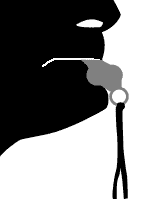During our training session over the weekend, I happened to randomly conjure up a few new cues.
As you may know, it is of utmost importance that your programming address stability in all planes.
To consider why you should train frontal plane stability, imagine your favorite contact sport. If someone attacks you from the side, frontal plane stability will keep you up and moving on. If you lack it, you’ll be thrown on the ground like a phone in a Lonely Island video. You can’t trust the system.*
If that joke lost you, watch this video after you’re done reading this post.
Moving on, the scenario involved Pete, a new intern at IFAST, and his 12″ step ups. His concentric (the stepping up) looked great, but he would “sag” into his working hip as he lowered himself back down.
So first I had to ask myself, “What are the options to make this look better?” I can either coach him out of his mistake, or we regress the exercise. Always try to coach them out of their mistakes first, and regress them only if you are unsuccessful. A lot of things come into play here, such as the client’s mobility, stability, and overall athleticism. Pete comes from a highly athletic background, so his capacity to control his movement will be much greater than the hypothetical housewife who has never played a sport in her life.
Next, I examined the problem asking myself, “What movements are happening?” His “sagging” caused adduction of the right hip, and a lengthening of the left ab wall, among other things. Now there are many possible causes for this, such as weak left obliques, overactive right quadratus lumborum, or weak right hip abductors. It’s important not to get caught up in muscles and instead focus on the movement when coaching. This is why the fitness industry has adopted the adage “train movements, not muscles”. The success ratio is much higher when evaluating movement.
After determining that, I decided we should try to get his trailing leg some stability and maybe that would clear things up. Luckily (or not), the problems went away and his movement looked much better.
I came up with the following two cues to improve frontal plane stability in Pete’s step up.
- Tapping the trailing leg’s heel.This is good for cuing the glutes to turn on.
- Pulling on the trailing leg itself. This is good for getting the left ab wall to turn on, as well as promoting a “suction” motion of the hip into the acetabulum (the socket).
Both seemed to work quite well, according to my eyes (a.k.a. Zach Moore). I would venture to guess that giving him an offset load of, say, 8kg in his right hand would also reflexively fix his stability, and that’s what we’re going to try next time.
One last point to address is the offset loading I just discussed. Why would we want to do that when the other cues have already worked?
- Less coaching intensive.With these two cues, I was behind Pete, pulling on his leg or tapping his heel, while Zach stood in front of him looking for a change. 2 trainers to 1 client is not a favorable ratio for making money and utilizing your time efficiently. Similarly, if the offset load works, he may not even need a coach for the most part.
- Adding a load.Our main goal with Pete is to groove the correct motor patterns before overloading him. 8kg is a very moderate load that will not tax the strapping young lad much at all, but it will introduce another factor for his body to combat.
- Did I mention you don’t have to coach him anymore?
That’s all I have for you today, but I’ve heard through the grapevine that Zach Moore has a blog coming up that will really dial home the idea of frontal plane stability, so be sure to keep an eye out for that. The dude continually puts out great content.
Until next time, happy training!

Add some color to this commentary.